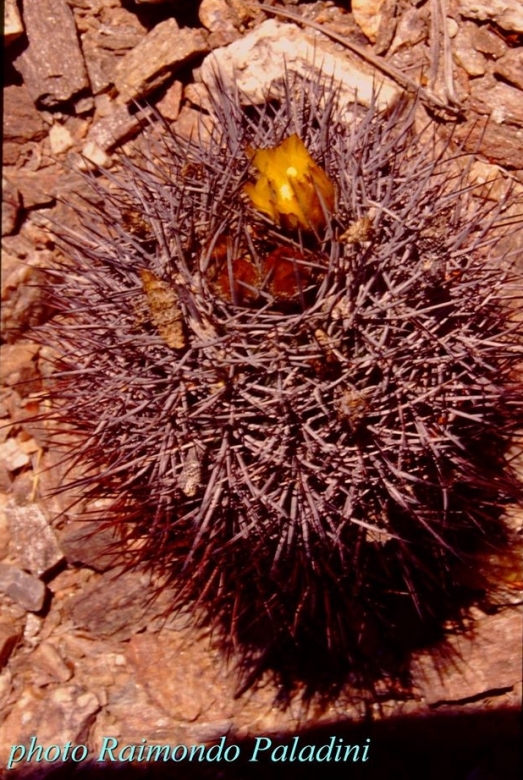Accepted Scientific Name: Eriosyce strausiana subs. pachacoensis (Rausch) Ferryman
16: 11 (11 Oct. 2003).

Pyrrhocactus pachacoensis (Eriosyce strausiana subs. pachacoensis) Photo by: Raimondo Paladini
Blooming habit at Santa Rosa valley, San Juan, prov. San Juan, Argentina. 23 December 2002.
Origin and Habitat: Argentina, San Juan in Pachaco and adjacent areas. Eriosyce strausianaSN|18]]SN|18]] subs. pachacoensis grows in a isolated disjunct area.
Altitude range: Around 1700 metres above sea level.
Synonyms:
See all synonyms of Eriosyce strausiana
Description: Eriosyce strausianaSN|18]]SN|18]] subs. pachacoensis (firstly described as Pyrrhocactus pachacoensisSN|2930]]SN|2930]] by Walter Rausch in 1975) is a local or morphological form of the widespread and variable Eriosyce strausianaSN|18]]SN|18]]. This subspecies has smaller solitary stems with dense pink-grey spines. However the distinguishing characteristics of subs. pachacoensis, appear to fall within the natural variation of Eriosyce strausianaSN|18]]SN|18]] and some authors have dismissed Eriosyce strausianaSN|18]]SN|18]] subs. pachacoensis as perhaps not worthy of even varietal status.
Derivation of specific name: This member of the Cactaceae family was given the name pachacoensis for the occurrence near Pachaco, San Juan, Argentina.
Stem: Single, spherical to slightly elongated, pale grey-green, glaucous, up to 10 cm tall and 8 cm in diameter.
Ribs: About 13, tuberculated vertical or slightly twisted. Tubercles up to 10 mm in length.
Areoles: Large, oval, 5 mm long at first covered with white felt later bare.
Central spines: Up to 2 curved upwards, greyish-pink, tip iridescent black, greying over the time, up to 3 cm in length.
Radial spines: 8-12 similar to central but thinner, whitish-grey to pink, 4 to 6 of which paired and one pointing downward bent toward the stem, 10-15 mm cm long. Spines all subulated thickened at the base.
Flowers: Nearly apical, Funnel-shaped, wide, yellow-green to yellow, 3.5 cm long and in diameter. Ovary conical green with small blue-green scales, with light-brown hairs. Tube with yellow-green, with yellow-green scales, ending in a brown papery tips with light-brown wool and long brown bristles. Outer tepals lanceolate, bent outward, pale yellow with red-brown median strip. Inner tepals lanceolate, toothed, pale yellow with wine red central stripe and tips. Throat yellow. Stamens and anthers light yellow. Style thick with 8 yellow stigma lobes.
Fruit: Barrel-shaped, 8 mm long and 5 mm in diameter, reddish brown, with white hairs, white and red-brown and dark-brown bristles.
Seeds: Kidney-shaped, 1.5 mm long, 1 mm thick, black-brown.
Bibliography: Major references and further lectures
1) Walter Rausch “Pyrrhocactus pachacoensis RAUSCH spec.nov.” Kacteen und andere Sukkulenten 26(4): 73-74 (1975)
2) Hunt, D. R. “The new Cactus Lexicon” (2 vols) DH books, Milborne Port 2006
3) Urs Eggli, Leonard E. Newton “Etymological Dictionary of Succulent Plant Names”. Birkhäuser 2004
Cultivation and Propagation: This slow growing cactus is kept for the beauty of its form and flowers. It is a summer grower species. Easy to cultivate but somewhat rot prone if kept in a non ventilated place, especially after planting.
Growth rate: Slow-growing and very long-lived. This cactus continues to be, a particular prize among collectors.
Soils: It likes very porous mineral cactus mix soil, but can become too elongated if compost is too rich.
Repotting: This plant needs plenty of space for its roots, repotting should be done every other year or when the it has outgrown its pot. Use pot with good drainage.
Watering: Needs moderate in summer, but do not overwater (extremely rot prone), keep dry in winter at a minimum temperature of 0°C.
Fertilization: Feed with a high potassium fertilizer in summer.
Hardiness: Reputedly resistant to frost if kept on the dry side prior to, and during, cold weather (hardy to -12 C ° C, or less for short periods), but for safe cultivation it is best to avoid freezing temperatures. It need a very good ventilation.
Exposition: The plant tolerates extremely bright situations. Blasting full sun encourages flowering and heavy spine production.
Pests & diseases: It may be attractive to a variety of insects, but plants in good condition should be nearly pest-free, particularly if they are grown in a mineral potting-mix, with good exposure and ventilation. Nonetheless, there are several pests to watch for:
- Red spiders: Red spiders may be effectively rubbed up by watering the plants from above.
- Mealy bugs: Mealy bugs occasionally develop aerial into the new growth among the wool with disfiguring results, but the worst types develop underground on the roots and are invisible except by their effects.
- Scales: Scales are rarely a problem.
- Rot: This species is not easy and accommodating, often suffer of cryptogamic diseases. The main problem with Argentinian pyrrhocacti is the scorching type disease on the apex. This disease seems to be worse on Eriosyce strausianaSN|18]]SN|18]] than the others species, it scorches just some plants, but it doesn't seem to be contagious. Takes a while but they can grow out of it. Root rot is a serious problem with pyrrhocacti if the plants are not watered and “aired” correctly. If they are not, fungicides won't help all that much.
Propagation: Seed or grafting. The seeds germinate with extreme difficulty and a low rate of success. Seedlings did not do well either, and some die each year.











